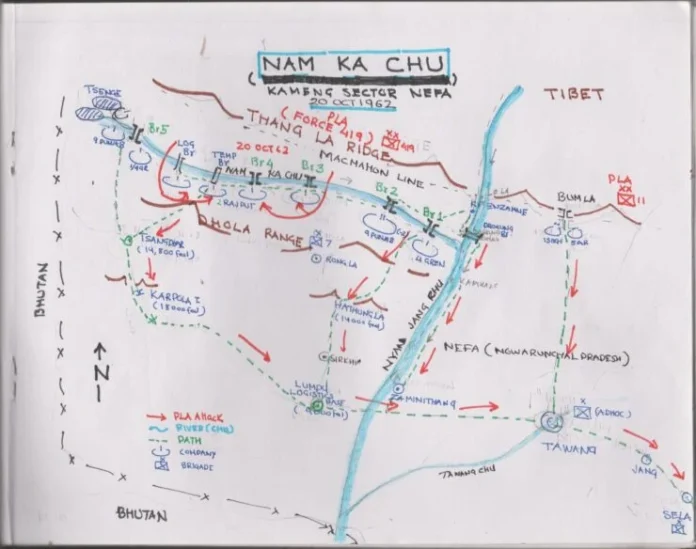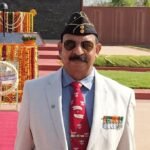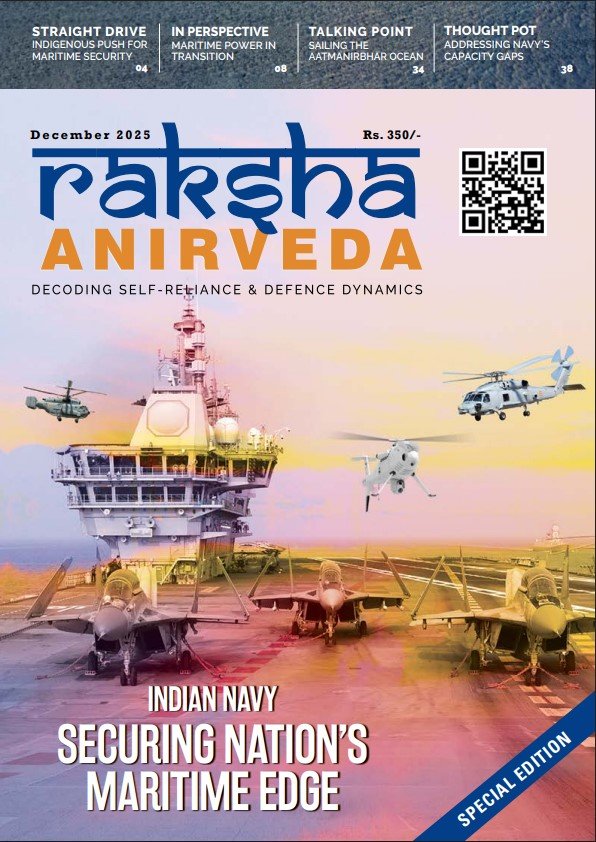My name is Namka Chu. My address is west Kameng District adjoining Bhutan border in North east frontier agency (NEFA) about 25 kms north of Tawang town. I am about 26 kilometres (km) long and flow from west to east at mild speed of 8 to 10 knots in winter season and 15 to 20 knots in monsoon. I flow between Thangla Ridge in north and Dhola range to the south. My width varies from 5 metres to 20 metres. My origin is from Twin reservoirs of Tsangle located at 17000 feet on trijunction of Bhutan, Tibet and India. My bed is full of rounded moss coated stones and few big rocks in the mid stream. I finally merge in to my elder sister river Nyamjang Chu at Dorkung Samba bridge which flows from North to south and merges down south into river Tawang Chu on India Bhutan frontier. I am a silent river but water stream makes pleasant sound when it skirts the big rocks in my path. Over the years, seven bridges have been constructed on my steep banks. The bridges are 3 to 5 kms from each other. These bridges were small steel wire rope suspension crossings where only in single line formation, a foot column could cross. If we move from east to west, Bridge 1 at Dorkung west , Bridge 2 north of Ron la, Bridge 3 near Dhola, Bridge 4, Log bridge, Temporary bridge and finally Bridge 5 on Tsanghdar and Tsangle Track. The area along the river had long grass but otherwise full of rolling stones and thorny bushes. I clearly recollect the story of October 20, 1962, when early morning at 5:00 am, 150 Chinese Artillery guns roared and about 1000 rounds landed on my southern bank and Dhola ridge .
Let me go back further. Indian 7 Infantry Brigade (Inf bde) had moved in on my southern bank and were deployed all along the southern bank from Bridge 1 to Bridge 5 in late September 1962. 4 Grenadiers were occupying defences on Dorkung bridge on Nyangjang river and Bridge 1, 9 Punjab occupied on Bridge 2 and Bridge 5. Bridge 3, 4, Log Bridge and Temp Bridge was held by 2 Rajput Battalion (bn). 1/ 9 Gurkhas were holding defences at Tsangdhar adm base, Dropping Zone and Karpola 1 along with a troop of 17 Para field unit. One company (coy) was deployed in protection of Lumpu logistics base about 8 kms from Tawang. I could hear the sound of digging defences throughout day and night. Small patrolling parties often come up to the river and observe northern side. These troops were tough and brave, equipped with Sten machine, 303 Springfield bolt action Rifles and Browning Light Machine guns with on weapon scale and unit reserve ammunition and had balaclava caps, OG jersey and short coat Parkha. The cold winds continued blowing bringing temperature below 20 degrees with wind chill factor. The troops were on constant vigil but not aware of what was brewing on my northern side.
I was aware and worried as Chinese Force 419 was marshalling on my northern bank on reverse slopes of Thangla Ridge with three regiments (154 Regiment , 155 Regiment and 157 Regiment and an additional Regiment ex 11 Chinese Div (please note one regiment is like a brigade with three battalions of 1000 troops each), which was to move on Bum La axis directly to Tawang. There was massive Artillery and Engineers build up. They had built a CL 9 road up to Thang la. By October 14, 1962, they had moved into Nyanjang valley and deployed in forward assembly area. A force of 12000 PLA troops were ready few miles away against an Indian brigade of 2000 soldiers. All intelligence agencies i.e. IB, SSB and Military Intelligence wing, including aerial reconnaissance missions were in Ostrich mode. Defence Minister Krishna Menon had convinced PM Nehru that it was a false alarm, Chinese will never attack. The water level in the my lap was 3 to 5 feet at fords and l was worried that Chinese may cross from river fords and not from Bridges, where Indian troops were focussed. In fact, PLA troops had infiltrated at 0100h silently between gaps in Indian posts.
At the first light of October 20, 1962, Sino India War started with heavy Pre H hour bombardment. Chinese troops had already crossed Namka Chu and attacked 2 Rajput company defended localities at Bridge 3, 4, Log Bridge and Temp Bridge. Surprisingly, Tsangle garrison with 9 Punjab and 1/9 Gurkha company in west and 4 Grenadiers and 9 Punjab company troops at Bridge 1 and 2 in east, were not addressed by Chinese force. Major B K Pant was the gallant company commander at Bridge 4, which faced the brunt of Chinese regiment with 3 battalions. They repulsed three waves of Chinese attacks. In the last, when company had suffered 75% casualty (82 out of 110 killed) Rajputs fought with bayonets, last man last round. Major Pant motivated his troops moving one trench to other. He was mortally wounded in stomach and both legs. His last words to his men were “Rajputs are born to die for the motherland. God has selected us to defend the blue water of Namka Chu. Meanwhile, B company at Log bridge and C company at Temp bridge were fighting another bloody battle with Chinese multiple human waves. Lieutenant Subash Chander who was commanding B company was also killed in close combat with the Chinese. Capt B S Mangat (Adjutant) and Capt G S Bhatia (Vrc), also were mortally wounded. A company under Capt Ravi Eipe which was along Bridge 3 with a platoon at Dhola post also lost 61 troops. The most surprising factor was that most of assaults were from multi direction including from south (rear) direction. The battalion headquarters was the last to be demolished. Maj Gurdial Singh, MVC, fought leading with HQ troops and inflicted heavy casualty on Chinese troops. He was severely wounded along with commanding officer Lt Col M S Rikh, both were taken POWs. Rajputs fought valiantly last man last bullet but were finally over run. 4 Officers and 278 gallant soldiers of 2 Rajput made supreme sacrifice and 81 valiants were critically wounded on that day within 4 hours of battle. I had tears in my eyes watching them fight and my water turning red with gallant Rajput blood defending frontiers of their nation.
The battle shifted to Tsangdar where Gurkhas fought valiantly and later their sharp khukris gave the Chinese bloody nose, E troop of 17 field fought open sights bravely and delayed the Chinese for few hours, were overrun. Punjabis and Grenadiers were outflanked, suffered heavy casualties at Hathung la pass. Brigadier John Parshu Ram Dalvi, a fighter, commander 7 Inf bde which ceased to exist within 48 hours and who was taken POW on October 22 called this war as Himalayan Blunder. Tawang garrison was abandoned on October 23. Se La defences disintegrated on November 16 and Bomdila fell on November 18, 1962. Despite vintage weapons, limited ammunition, inclement weather, lack of cold weather clothing, lack of Arty support and without offensive air support, the Indian soldiers fought bravely in Kameng sector of NEFA. The War in Himalayas suddenly ended with China declaring unilateral ceasefire on November 21, 1962. PLA moved back to Macmahon Line.
This real story is written by me (Namka Chu) with tears in my eyes remembering the fallen heroes of Indian Army who smilingly laid down their lives defending this great country called India on my southern bank. I can still feel the brave hearts hugging me like a child to loving mother.
-The writer is an Indian Army veteran and a defence analyst. He has keen interest in Geo-strategic affairs and writes regularly on internal and external affairs issues related to India and neighbours. The views expressed are personal and do not necessarily reflect the views of Raksha Anirveda.
-The writer is an Indian Army veteran and a defence analyst. He has keen interest in Geo-strategic affairs and writes regularly on internal and external affairs issues related to India and neighbours. The views expressed are personal and do not necessarily reflect the views of Raksha Anirveda






